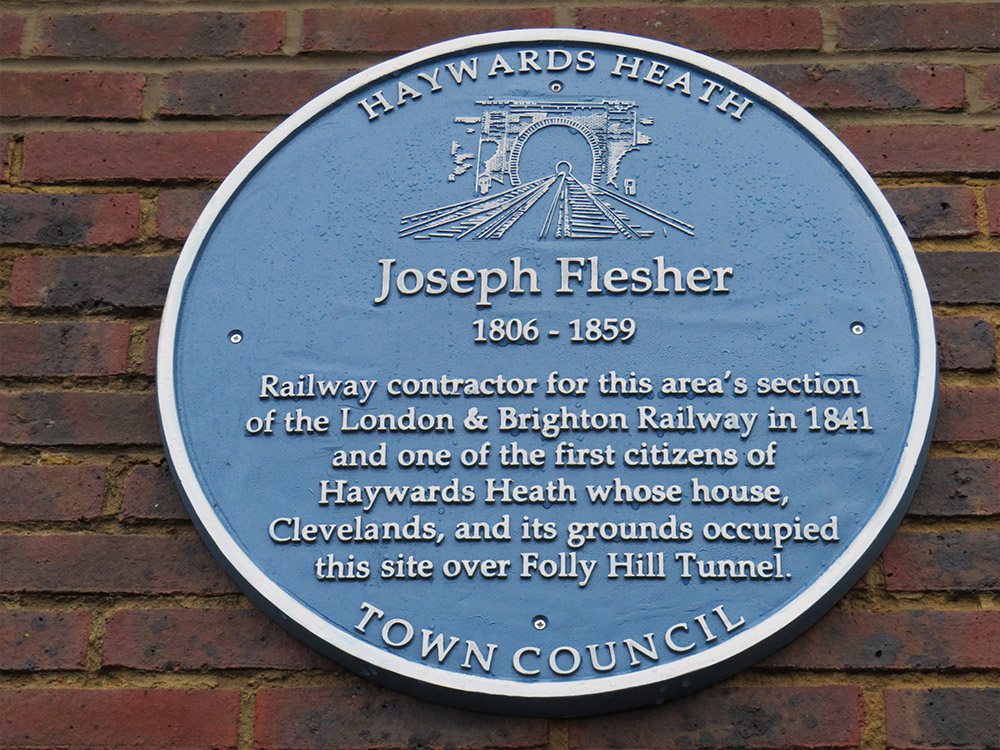Blue Plaque Unveiling
Published: 20 December 2018
Cllr Sandy Ellis and members of Joseph Flesher's family unveiled a Blue Plaque on the NatWest building at 1 Muster Green today to celebrate Joseph Flesher 1809-1856. Mr Flesher was the railway contractor responsible for this area's section of the London and Brighton Railway in 1841, playing a pivotal role in the construction of the Folly Hill Railway Tunnel, and was one of the first citizens of Haywards Heath, whose house (Clevlands) occupied the grounds on this site over the Tunnel.
Cllr Sandy Ellis, said:
"It was inspiring to help with this project on behalf of Mr Flesher's relatives at the NatWest building close to the Folly Hill Tunnel. Haywards Heath Town Council endorsed the adoption of Blue Plaques to show its support for commemorating buildings, famous people or events that have contributed to the history and heritage of this town. This iconic landmark is seen daily by thousands of passengers who travel on the London to Brighton line and it is an honour to be able to leave such a wonderful tribute to a local resident and an outstanding engineer of his day.
The Haywards Heath Historical Society and Cuckfield Museum have also given their support and shared local knowledge which has helped with the installation of this blue Plaque and it has been generously financed by local ward Councillors and NatWest bank. Mr Fisher's relatives are delighted that the HHTC Councillors and NatWest are recognising the great achievements of their Great Great Grandfather in the form of a Blue Plaque."
Gwynneth Busfield, great granddaughter of Joseph Flesher added:
"I am so pleased that Joseph's life has been commemorated by this plaque. Without the coming of the railway to Haywards Heath, we wouldn't be here today! Thank you so much everyone for helping with the research and making this happen."
Blue plaques memorialise the connection between building or location and a famous person or event. The NatWest building was chosen for the Blue Plaque as it now occupies the land that was the former home and grounds of Clevelands and is located by the Folly Hill Tunnerl where Mr Flesher was an engineer. The unveiling was attended by Joseph's great granddaughter , Gwyneth Busfield, his great, great granddaughter, Susan Parsons and his great, great grandson, Keith Busfield.

Information on Joseph Flesher
'Mid Sussex Through the Ages' by A.H. Gregory published by Charles Clarke, ('The Mid Sussex Times Offices) in 1938 p.95
'A hundread years ago (he is writing in the 1930's) Haywards Heath consisted of two inns, eight farmhouses, one windmill and house, and nine cottages - a total of twenty, including one block of three. The Heath was a wide waste of gorse and heather, dotted here and there with clumps of Scotch firs, surrounded by small farms, and with a windmill at the highest point, and traversed by two highways crossing at approximately right angles. Cuckfield decided that it did not want the railway and the route was altered to one passing through the Heath. No doubt the promoters were also influenced by the idea that a station midway between Cuckfield and Lindfield would possibly be in a better position that one at Cuckfield. So the centuries old sleep of the Heath was broken by the arrival of an army of North country navvies, and the great change had begun, the railway being completed in 1841. A north countryman, Mr Flesher, the contractor for this section of the line, took such a liking to the place, that during the progress of the works, he built a house for himself on top of the tunnel, which under much altered conditions was known as the Clevelnads. It was the first house to be built as a direct result of the railway.'
This account is referred to in the well respected local history book 'The Metropolis of Mid Sussex - A History of Haywards Heath' by Wyn Ford Published in 1981 on p90
'Clevelands, at the eastern end of Muster Green, is believed to have been the first house built as a direct result of the railway and was originally the home of a Mr Flesher, the contractor responsible for the construction of the line through the area.'
Colin Manton, the Haywards Heath Historian, in his 2013 'Haywards Heath Through Time' has written on p63:
'Clevelands was probably the first Haywards Heath residence built as a direct result of the railway, sited on the top of the Muster Green Tunnel. It was the home of Mr Flesher, the contractor responsible for driving the railway through the district. The building was demolished and replaced by the Muster Court apartment block in the late 1950's. These apartments overlook the great Victorian railway cutting to the South and a circular ventilating tower stands in the grounds.'